The Amazing (If True) Story of the Submarine Mechanic Who Blew Himself Up Then Surfaced as a Secret Agent for Queen Victoria
The leading mechanic of the famed H.L. Hunley led quite the life, if we can believe any of it
:focal(407x228:408x229)/https://tf-cmsv2-smithsonianmag-media.s3.amazonaws.com/filer/bf/84/bf84e66b-306c-42ba-b6d8-9a0cc1e63a90/clintock_daguerrotypeedit.jpg)
At 8:45 on the evening of February 17, 1864, Officer of the Deck John Crosby glanced over the side of the Federal sloop-of-war Housatonic and across the glassy waters of a calm Atlantic. His ship was blockading the rebel port of Charleston from an anchorage five miles off the coast, and there was always the risk of a surprise attack by some Confederate small craft. But what Crosby saw that night, by the dim light of a wintry moon, was so strange that he couldn’t be certain what it was. “Something on the water," he recalled to a court of inquiry a week later, "which at first looked to me like a porpoise, coming to the surface to blow.”
Crosby alerted the Housatonic’s quartermaster, but the object had already disappeared—and when he saw it again, a moment later, it was too close to the sloop for any hope of escape. As the Housatonic’s crew scrambled to their battle stations, there was a huge explosion on the starboard side. Their ship sank in minutes, taking five crewmen with her.
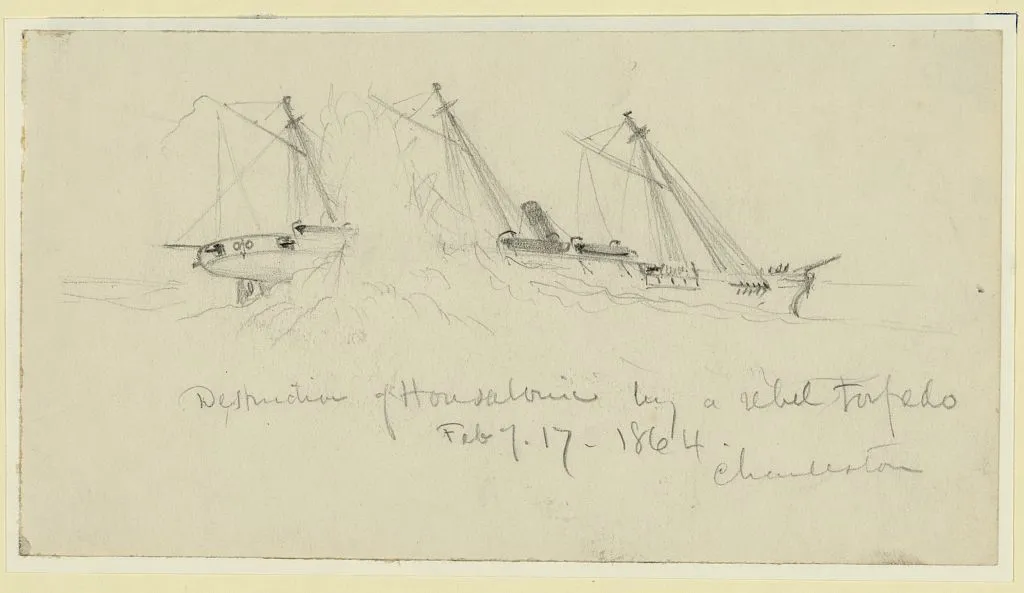
It was not clear until some time later that the Housatonic had been the first victim of a new weapon of war. The ship—all 1,240 tons of her—had been sunk by the Confederate submarine H.L. Hunley: 40 feet of hammered iron, hand-cranked by a suicidally brave crew of eight men, and armed with a 90-pound gunpowder charge mounted on a spar that jutted, as things turned out, not nearly far enough from her knife-slim bow.
The story of the Housatonic and the Hunley, and of the Hunley’s own sinking soon after her brief moment of glory, of her rediscovery in 1995 and her eventual salvage in 2000, has been told many times. We know a good deal now about Horace Hunley, the Louisiana planter who assembled the syndicate that paid for the submarine. We know about the design defects and the human errors that drowned two earlier Hunley crews, 13 men in all. We even know a little of James McClintock and Baxter Watson, the two mechanics who built the Hunley—not least that McClintock was the man who actually designed her, and so is probably the most important person in the story.
What has not been known, at least until now, is exactly what became of James McClintock. The Hunley’s hundreds of historians sketch his story in a sentence or two. They take their information from McClintock’s grandson, Henry Loughmiller, who—writing to the researcher Eustace Williams—explained that his ancestor was “killed [in 1879] at the age of 50 in Boston Harbor when he was experimenting with his newly invented submarine mine.”
It seems to be a fitting ending, but the Loughmiller account has been repeated endlessly for more than half a century without being checked. Yet fresh research suggests that each part of the story is dubious. Those who met James McClintock in 1879 thought him much closer to 60 years old than 50; the explosion that supposedly claimed his life took place outside Boston Harbor, and the evidence that it killed him is remarkably flimsy. Many people heard the explosion, but not a single person witnessed it. There was no body. There was no inquest. Not so much as a shred of mangled flesh was ever recovered from the water. And 16 months later, in November 1880, a man who said his name was James McClintock walked into the British consulate in Philadelphia to tell a most outlandish tale—and offer his services to Queen Victoria as a secret agent.
James McClintock spent his boyhood navigating not eastern harbors, but the great rivers of the American interior. Census records confirm that the inventor was born in Ohio, and family tradition suggests that he grew up in Cincinnati and left home at an early age to join the crew of a Mississippi riverboat, acquiring sufficient skill to become “the youngest steamboat captain on the river” in the years before the Civil War. At some point, McClintock also began to show talent as an engineer and inventor. Caught in New Orleans by the war, he and Baxter Watson drew up plans for a new machine for making Minié balls, the rifled-musket bullets used by both sides throughout the conflict.
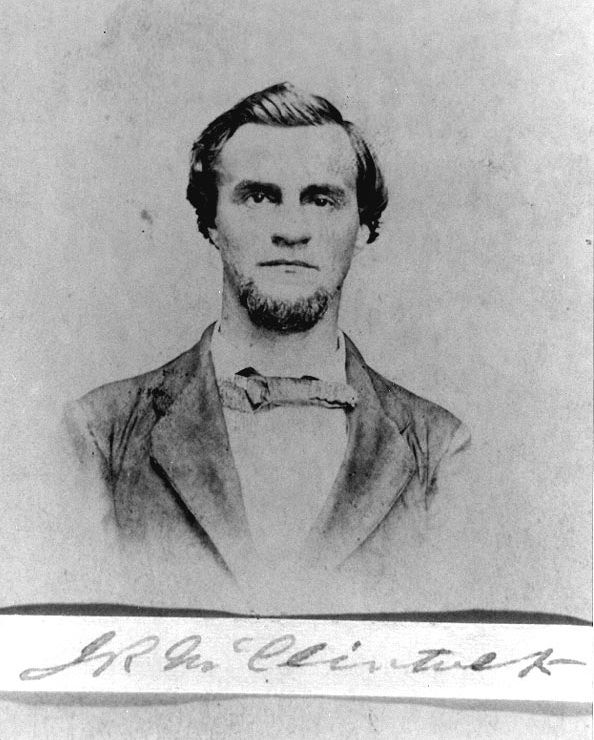
According to the New Orleans Bee, the two men boasted that their invention would cost only $2,000 or $3,000 to make, and “with it two men can turn out a thousand balls per hour, or with steam power it makes eight or ten thousand per hour. This one machine, worked night and day, could turn out 1,200,000 balls every week, more than enough to supply the Confederate armies in the most desperate and extended war possible.”
The Minié ball machine was never made, most likely because its usefulness had been thoroughly exaggerated. But it served as a calling card, and must have helped to persuade Horace Hunley to assemble a consortium that invested somewhere north of $30,000 in McClintock’s submarines. Reading between the lines of Civil War accounts, it seems likely that it was the desire to recover this investment, as much as patriotic fervor, that persuaded the boats’ owners to persevere in the face of repeated disaster: at least three sinkings, reported stiflings and near-stiflings, and even the death of Hunley himself, who, having fatally dived to the bottom during trials at Charleston in October 1863, was recovered with his crew when the submarine was salvaged three weeks later—“a spectacle,” one contemporary report related, “indescribably ghastly; the unfortunate men were contorted into all kinds of horrible attitudes, some clutching candles, evidently attempting to force open the manholes; others lying in the bottom, tightly grappled together, and the blackened faces of all presented the expression of their despair and agony.”
Of all the men known to have boarded the Hunley, indeed, only about half a dozen escaped death in her belly. But McClintock himself survived the war, and when, in the fall of 1872, he traveled to Canada in an attempt to sell his submarine designs to the Royal Navy, the officers who interviewed him proclaimed themselves “strongly impressed with the intelligence of Mr. McClintock, and with his knowledge on all points, chemical and mechanical, connected with torpedoes and submarine vessels.”
What led McClintock to Boston is only hazily known. By 1879 he was living in New Albany, on the Ohio River at the southern tip of Indiana, where his occupation was recorded as “salesman.” This suggests that his fortunes had reversed since 1872, when he had been the moderately prosperous owner-operator of a dredge boat on Mobile Bay. He was also married and the father of three daughters, and the evidence suggests that he had plenty of motivation to leverage his expertise in building secret weapons in the hope of snagging a fortune in the shady private armaments market.
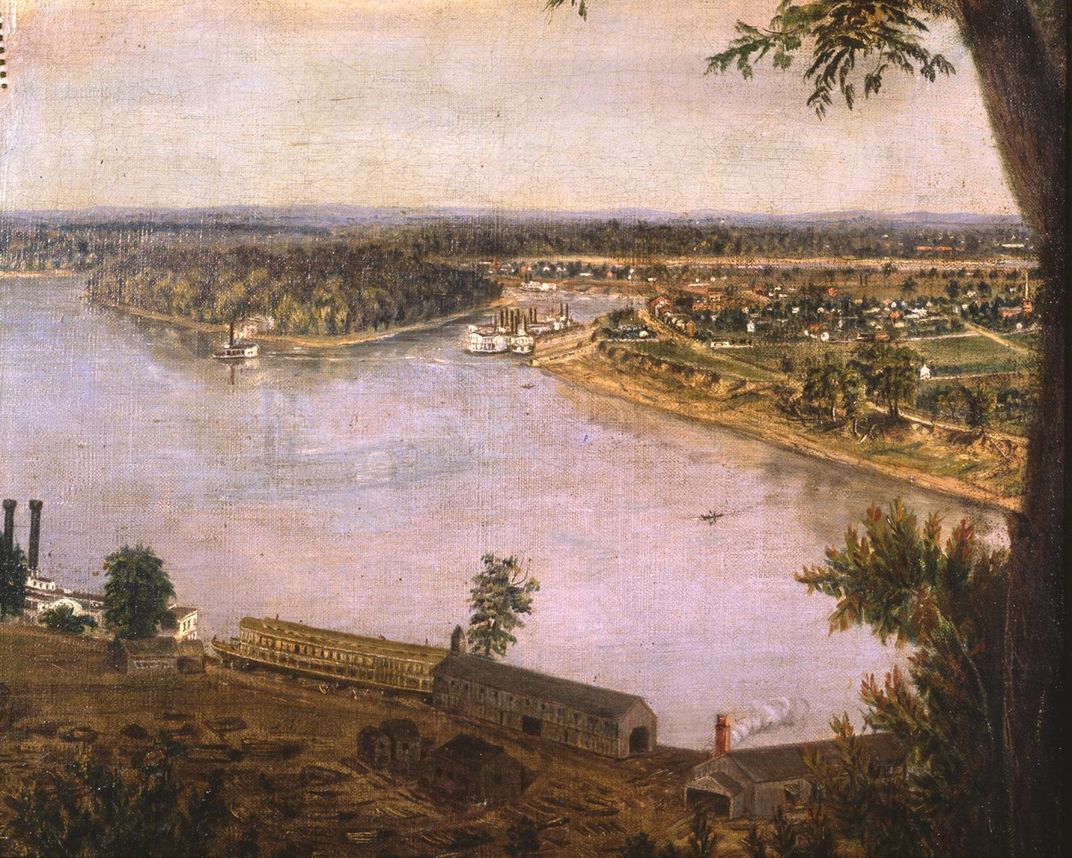
By 1877, certainly, McClintock had established contact with two other men who shared these views—George Holgate, a Philadelphian just setting out on what would become an infamous career as a free-lance bomb-maker, and a mysterious New Orleans river pilot by the name of J.C. Wingard, who had been with him in Mobile during the war. Both of these men were extraordinary characters.
Holgate, who seems to have been born in lowland Scotland, was the prolific inventor of an alarming collection of elaborate explosive devices that he hawked to all comers—Irish freedom fighters, Cuban patriots and Russian nihilists. “I no more ask a man,” he informed one newspaper reporter, “whether he proposes to blow up a Czar or set fire to a palace...than a gunsmith asks his customers whether they are about to commit a murder.” He claimed to be the former proprietor of a London paint shop that had been a front for a bomb-making business, though there is no trace of any such activities in a British press that became obsessed with bombers when the Irish Republican Brotherhood—a precursor to the IRA—began deploying them in London in 1867.
By the early 1870s, Holgate was living in Oshkosh, Wisconsin, where he purchased a gun shop and touted a highly dubious invention that, he boasted, used injections of ozone to keep fruit, vegetables and even beef fresh for weeks. He was, the local Northwestern newspaper would recall, a “blatherskite” and “blowhard...one of those wild erratic individuals who now-a-days are gaining such cheap notoriety by cheap means.” But he was also—potentially, at least—a very dangerous man. The wares that he touted, Ann Larabee records, included a good deal more than conventional explosives:
a cheap hand grenade, a bomb concealed in a satchel that had a fuse running through its keyhole, and a hat bomb comprised of dynamite pressed between two sheets of brass sewn into the crown with a fuse running around the rim. His “Little Exterminator” operated through a delicate watch mechanism that moved a tiny saw, releasing a chemical that smelled like cayenne pepper, killing anyone within one hundred feet.
Wingard was even more remarkable. When the Civil War disrupted an early sideline as a prominent medium, he too turned to invention, re-emerging in New Orleans in 1876 as the proprietor of a death ray that he claimed was powerful enough to annihilate enemy ships across several miles of open water. Although a self-styled river “captain,” Wingard was almost entirely uneducated—“a plain, simple, straightforward man,” Emma Hardinge wrote in 1870. But he exhibited extraordinary talents as a medium.
Amid the great spiritualism craze, which had burst on the United States late in the 1840s, Wingard became renowned as early as 1853 as a faith healer and for the “spirit drawings” he produced in darkened séance rooms “on paper which had previously been examined and found not to contain any marks.” His most remarkable performances, however, involved the production of automatic writing, messages that were supposedly produced by spirits that had taken control of a medium’s body. According to Thomas Low Nichols, the revivalist preacher Jesse Babcock Ferguson swore that he had seen Wingard “write with both hands at the same time, holding a pen in each hand, sentences in different languages, of which he was entirely ignorant. He saw him, as did many other persons of undoubted credibility, write sentences in French, Latin, Greek, Hebrew, and Arabic.”
The Civil War found Wingard in New Orleans. Just as the crisis had turned James McClintock’s interests toward bullets, it focused Wingard’s thoughts on an early sort of machine gun. This device was never built, but like the Minié ball machine it was extravagantly promoted. Wingard claimed that weapons made to his design would be capable of discharging 192 bullets a minute “at a range as great as any gun then in use.”
Wingard’s interest in mechanical death-dealers persisted after the war, and early in 1876 he reappeared in New Orleans, calling himself “Professor” Wingard and claiming to have invented an astonishing new weapon capable of annihilating enemy warships at distances up to five miles. The manner in which this destruction was to be effected was left vague, though Wingard mentioned electricity—which, in the 1870s, was a new, powerful and poorly understood form of energy—and a separate Nameless Force, which in some mysterious way transmitted electrical power across water and focused it upon its target. This Nameless Force, he promised, would become “a factor controlling the destinies of a nation.”
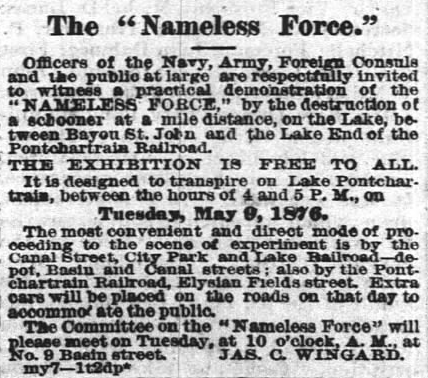
The tremendous public interest in Wingard’s invention survived two unsuccessful efforts to put the Nameless Force to work on Lake Pontchartrain. Chastened by his double failure, Wingard decided not to invite the New Orleans public to a third demonstration on June 1, 1876, but a “committee of gentlemen” was present when, at 2:35 p.m., the Professor—a small figure just visible across a mile or more of water—fired the weapon from a skiff. It was aimed at the Augusta, an old wooden schooner that had been anchored about two miles away, off a popular amusement park on the southern shore known as the Spanish Fort.
This time, it seemed, the Nameless Force took effect, and the Augusta “suddenly blew up” about 90 seconds after Wingard’s invention was discharged. When the witnesses reached what remained of the vessel, they found her “shattered in small fragments,” and it seemed all the more impressive that Wingard “could not receive the congratulations of his friends” as he had somehow sustained severe burns to one hand in the course of the operation.
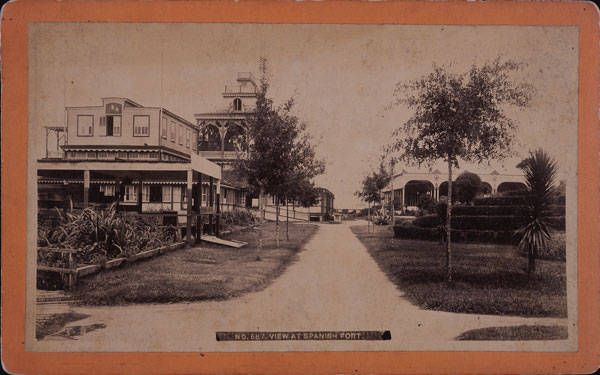
From our perspective, though, the most important aspect of the demonstration was not Wingard’s brief lionization in New Orleans, but a deflating coda reported by the Galveston Daily News a few days later. According to that paper, “a delegation of newsboys, who happened to be in the vicinity, with a spirit of scientific research...visited the schooner despite repeated warnings to keep away, and reported that they found a large gas pipe filled with powder, and a wire leading towards [the skiff] that was anchored some distance away.” The entire demonstration, thus, had been a fraud; the only force involved, the News concluded, was a quantity of gunpowder concealed beneath the Augusta’s decks, and a long wire, “tightened by means of a windlass on the skiff,” that triggered the explosive. This discovery dented Wingard’s reputation, and he seems not to have been heard from again until he appeared in Boston late in 1879.
What happened to McClintock, Holgate and Wingard in Massachusetts can be established from local newspaper reports. The men appeared in Boston in the first days of October and chartered first the steamboat Edith and then, on October 13, a sailboat, the Ianthe, with a rowboat as tender and a Nantucket man named Edward Swain as crew.
On the afternoon of the 13th, Swain sailed the Ianthe to a spot off Point Shirley, to the east of Boston Harbor. It is at this point that accounts become confused, but the most considered and most detailed state that Wingard had taken command of the Edith and was towing an old hulk that was to be used as a target. Holgate, who had been due to join Swain in the tender, complained of seasickness and retreated into the Ianthe’s deckhouse to lie down, so McClintock took his place, carrying with him a “torpedo”—mine—packed with 35 pounds of dynamite, which (the Boston Daily Advertiser reported) he had boasted was powerful enough to “blow up any fleet in the world.” He and Swain rowed off.
Shortly thereafter, with the tender about a mile from the Ianthe and two miles from the Edith, there was an ear-shattering explosion. Wingard told the Advertiser that he had been “looking the other way” at the fatal moment but turned in time to see a column of spray and debris rising high into the air. Holgate, who said he had been lying in his bunk, likewise missed the explosion, but when the Ianthe and the Edith converged on the spot there was no trace of McClintock or Swain; all they could see floating on the surface was a mass of splinters.
Neither Holgate nor Wingard seems to have been eager to make comments to the press, and both men quickly fled Boston—Holgate after securing McClintock’s possessions from his hotel room and without reporting the incident to the police. “He had a horror of recounting the event,” the Philadelphia Times explained after interviewing the old bomb-maker two decades later, “and so he said: ‘There can’t be an inquest unless there is a body to hold it upon, and there is not even a scrap left of my unfortunate companions.’ ” Indeed, the local authorities took remarkably little interest in what had happened. There seems to be no trace of any real investigation, nor even much curiosity as to why a trio of civilians were experimenting with unregulated explosives.
Thus far, the accounts in contemporary newspapers contain nothing to contradict Henry Loughmiller’s belief that his grandfather died that day in Boston. But they offer odd pieces of testimony that do not mesh with the tales that Holgate and Wingard told. The Daily Globe, for instance, reported that Holgate’s involvement in the catastrophe had been greater than he was willing to admit; the “torpedo” was electric, the Globe explained, and the explosion had occurred when Holgate somehow set the charge off remotely. Strangest of all was a note in the same paper stating that a reliable witness—a hunter out shooting at Ocean Spray—had seen McClintock’s rowboat still afloat after the explosion, “so that the men, he thinks, could not have been blown to pieces.”
Nothing came of any of this at the time. Holgate hastened to New York, and then home to Philadelphia, wiring McClintock’s family—so he said—to tell them of the awful accident. Wingard vanished. Boston’s harbor police dropped the halfhearted enquiries they had made, and nothing more was heard from any of the participants for more than a year.
A good deal happened in the interim, however. Perhaps the most significant of these developments took place in New York, where an ambitious splinter group from an Irish secret society known as the Clan na Gael began to plan a large-scale terrorist campaign on the British mainland. Led by Jeremiah O'Donovan Rossa, an Irish journalist who had been elected “Head Centre” of the Fenian movement in the United States, it began raising funds and looking for ways to manufacture bombs and smuggle them across the Atlantic.
O’Donovan Rossa and his associates were nothing if not ambitious—they raised $43,000 (just over $1 million today) with the aim of spreading “terror, conflagration and irretrievable destruction” the length and breadth of England, and established a “Dynamite School” in Brooklyn to teach recruits how to make, conceal and use their bombs. But Rossa was also enduringly indiscreet about their plans, and by the fall of 1880—a year after the explosion in Boston, but months before their terror campaign was due to begin—British diplomats in the United States were in a state of high alert, and desperately seeking information about how Rossa planned to spend his money.
It was against this background that Robert Clipperton, the British consul at Philadelphia, received an unexpected visitor in October 1880. This man introduced himself as James McClintock, explained that he had a background in submarine and mine warfare—and revealed that he had been hired by Rossa’s Skirmishing Fund to build 15 examples of a new sort of torpedo so powerful that a single weapon filled with 35 pounds of explosives “could sink an ironclad if exploded under her bottom, and could be carried in a great-coat pocket.”
This McClintock’s purpose in calling on Clipperton was to offer his services as a double agent. In exchange for payments of $200 ($4,650 today) each month, he was willing to betray his employers, slow down the work, hand over samples of the weapons and guarantee not to supply working models to Rossa’s terrorists.
Clipperton was impressed by his visitor, and so were the consul’s masters at the British embassy at Washington. The British naval attaché, Captain William Arthur, arrived posthaste in Philadelphia, where on November 5 he met with McClintock and recommended his recruitment as a spy. The weapons, Arthur wrote, seemed viable, and the informant’s plans were workable—the doubt was his loyalty, not his truthfulness. As a result of this report, the man calling himself McClintock was paid $1,000, and Clipperton and his assistant, George Crump, continued to meet with him well into 1881. That March, the consul was handed samples of three different sorts of bomb—one disguised as a lump of coal and intended to be slipped into the bunkers of a transatlantic steamship, to explode with catastrophic consequences when it was shoveled into a furnace while the ship was out at sea.
But who was the man whose appearance in Philadelphia caused Clipperton’s diplomats so much concern? Nothing in the official correspondence—lodged today in Britain’s National Archives—contains a physical description of the informant. But we can say he was just as traitorous as he appeared to be. By the time the official record petered out, in July 1881, he had extracted a four-figure sum from both Rossa’s Irish freedom fighters and Queen Victoria’s secret service fund. Moreover, he had betrayed both of his employers. Rossa never received his final consignment of torpedoes, and the samples that McClintock supplied to the British were fakes—“the contents of his cases are not dynamite,” a worried official reported from London when the test results came in, “but a powder made to resemble it of a very slightly explosive quality.”
This James McClintock slipped away before either the British or the Fenians could lay hands on him. It seems that he was never heard from again.
So who was the Philadelphia McClintock? There are certainly problems with the idea that he was the same man who was supposed to have died in Boston in 1879. That McClintock never returned to his family. He was listed as dead—killed in Boston—in the mortality schedule for 1880 that was compiled in his hometown in Indiana, and his grandson knew of nothing to suggest this was not true. And Holgate was vividly retelling the story of McClintock’s atomization as late as 1896.
One possibility is that Clipperton’s informant was Holgate, posing as his old partner. A few details suggest that this might be the case. One is that “McClintock” chose to reappear in Philadelphia—which was, by 1880, Holgate’s home. The other is that the man who turned up at the British consulate explained that his device contained 35 pounds of explosives. Perhaps not coincidentally, that was precisely the size of the device that Holgate told the Boston press had blown up James McClintock.
But would Holgate really have had much to gain by posing as his former partner? True, Holgate was no expert in underwater warfare, while McClintock was. But McClintock’s name would have carried no weight with any British diplomat in 1880. His role as the designer of the Hunley had never been disclosed. His visit to Canada had remained a state secret. And it would not be until well into the next century that his role in the destruction of the Housatonic would be celebrated.
The only other plausible alternative is that the Philadelphia man was exactly who he claimed to be. Of course, for McClintock to have survived the explosion in Boston, he would have had to fake his death—and probably to become a murderer as well, for the unfortunate Edward Swain was never seen again. He would surely have needed a good reason to take these drastic steps, and it is possible to speculate that he had one—by the time he got to Boston, he was definitely short of money, and a spectacular apparent death might have seemed a good way to escape his creditors, or perhaps an angry backer calling in a loan.
In the final analysis, however, we cannot be certain that McClintock was desperate, and there are really only two ways to determine whether Clipperton’s informant was the man he said he was. One is to ask whether the events of 1879 make any sense viewed as a fraud. The other is to search the British archives for scraps of information that could have been provided only by the real McClintock.
Certainly it strains credulity to suppose that McClintock rigged an explosion and then made a clean getaway without assistance from Wingard or Holgate. It would have been all but impossible for him to have escaped the scene without being noticed by one of them. And that the two men might have helped McClintock fake his death is not implausible; neither was a paragon of decency. But it is hard to imagine what their motive might have been, unless McClintock was their boss and paying them.
Holgate’s accounts do suggest that his partner was the man in charge. But a clue buried in the Boston Daily Advertiser suggests that this was not the case. According to the Advertiser’s files, Wingard lodged at the United States Hotel, McClintock and Holgate at the Adams House. Since the United States was Boston’s second-best hotel, while the Adams House was a theater district dive, the implication is that it was Wingard who had hired the other two. This certainly ties in with a note that appeared weeks later in the Chicago Daily Tribune, which reported that Wingard had traveled to Boston to stage another fraudulent trial of his Nameless Force for the benefit of fresh investors, and that he spent the first half of October assembling a joint stock company willing to plough $1,500 into his venture. The explosion put an end to that (the Tribune wrote), and a shaken Wingard confessed to his investors that the blast had taken place while two of his men were on their way to install hidden charges on the hulk selected for his demonstration.
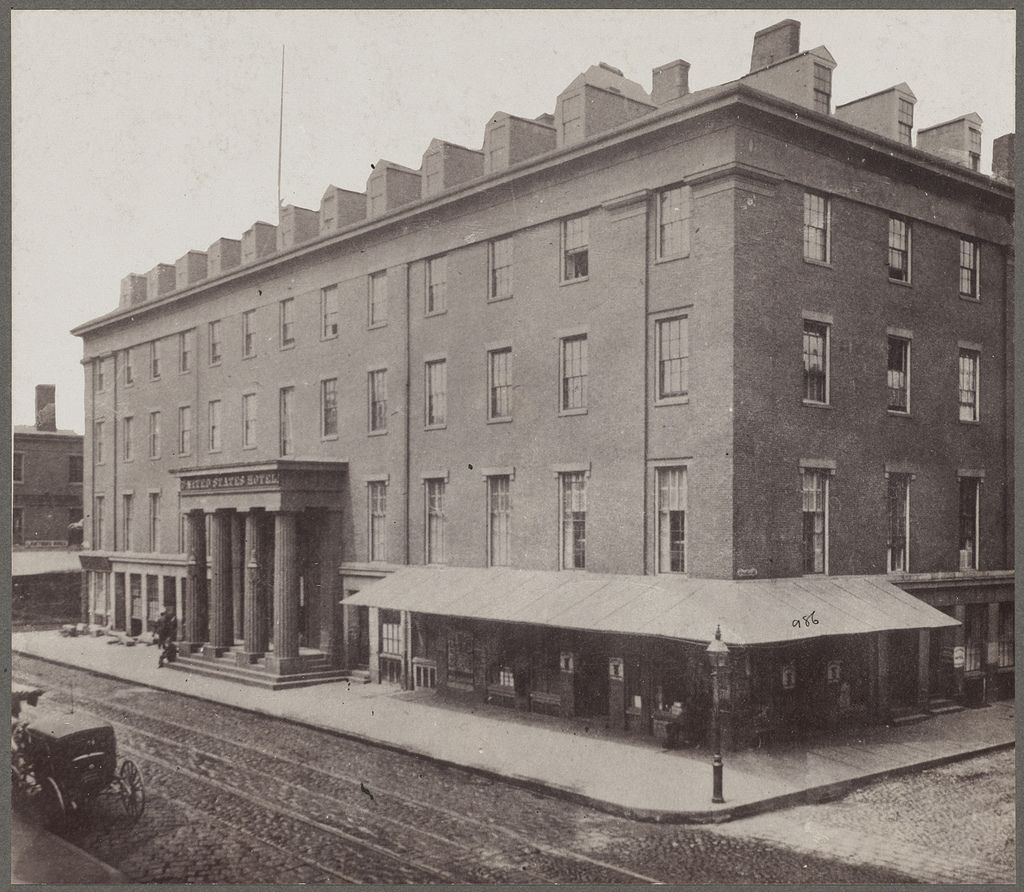
But if Wingate had no motive to assist McClintock, the same may not have been true of George Holgate. In this scenario, McClintock simply stayed on board the Ianthe with his partner and sent Swain off to die in the rowboat. The fact that the explosive charge was designed to be detonated remotely by wire, just as it had been in New Orleans, adds some weight to this theory, for if Swain rowed off trailing cable, as he must have done, the charge could have been detonated at any point—and, as the Boston Globe alleged, the explosion could have been triggered by Holgate. All McClintock needed to do at that point was to stay below while the Ianthe and the Edith converged upon the fatal spot. Wingard would have been none the wiser, McClintock would have escaped his creditors, and Holgate would have been owed favors by a man with extensive experience of explosives and underwater warfare.
Bearing all this in mind, perhaps the salient point is this: the Philadelphia McClintock was able to convince the British naval attaché, Captain Arthur, that he knew all about mines and submarines. This would not have been an easy trick to pull, for Arthur was also an expert; his last posting before coming to America was as Captain of HMS Vernon, the Royal Navy’s chief research establishment for underwater warfare. So maybe, just maybe, the triple agent who tricked British officials and Irish terrorists in Philadelphia, and got away with $2,000 and his life, was precisely who he said he was: James R. McClintock, inventor of the H.L. Hunley, betrayer of countries, causes, friends and his own family, and the faker of his own strange death.
Sources
British National Archives: Admiralty papers. “Submarine warfare,” 1872, Adm 1/6236 part 2; “Fenian schemes to employ torpedoes against HM ships,” 1881, Adm 1/6551; digest for August 9, 1872 and October 19, 1872 at cut 59-8 of Adm 12/897; digest for February 8, 1873 at cut 59-8 of Adm 12/920. Foreign Office Papers. New Orleans consulate. Cridland dispatch no.2 commercial of April 5, 1872 enclosing statement by James McClintock, March 30, 1872, and Cridland to Foreign Office July 17, 1872, both in FO5/1372; Fanshawe to Cridland, December 20,1872, Cridland dispatch no.7 commercial of January 3, 1873, McClintock to Cridland, January 7, 1873, Cridland to Foreign Office, May 25, 1873, all in FO5/1441. Philadelphia consulate. Political correspondence for 1881 in FO5/1746 fols.100-02, 146-7; FO5/1776, fols. 65-71, 80-5, 247, 249, 265, 291; FO5/1778 fols. 289, 403; United States censuses 1860 and 1870; Eustace Williams, "The Confederate submarine Hunley documents," np, Van Nuys, California, 1958, typescript in the New York Public Library; Anon. "Some scientific hoaxes." In Chambers's Journal of Popular Literature, Science, and Art, June 12, 1880; Victor M. Bogle. “A view of New Albany society at mid-Nineteenth Century.” In Indiana Magazine of History 54 (1958); Boston Daily Advertiser, October 15, 16, and 20, 1879; Boston Evening Transcript, October 15, 1879; Boston Daily Globe, October 14, 15, 16 and 20, and November 17, 1879; Boston Weekly Globe, October 21, 1879; Carl Brasseaux & Keith P. Fortenot. Steamboats on Louisiana's Bayous: A History and Directory. Baton Rouge: Louisiana State University Press, 2004; Chicago Daily Tribune, November 14, 1879; Mike Dash. British Submarine Policy 1853-1918. Unpublished PhD thesis, University of London 1990; Esther Dole. Municipal Improvements in the United States, 1840-1850. Unpublished PhD thesis, University of Wisconsin 1926; Ruth Duncan. The Captain and Submarine H.L. Hunley. Memphis: privately published, 1965; Charles Dufour. The Night the War was Lost. Lincoln NE: Bison Books, 1964; Eaton Democrat (OH), June 20, 1876; Floyd County, Indiana, mortality schedule, 1880; Galveston Daily News, June 6, 1876; Emma Hardinge. Modern American Spiritualism: A Twenty Years' Record. New York: The Author, 1870; Chester Hearn. Mobile Bay and the Mobile Campaign: the Last Great Battles of the Civil War. Jefferson [NC]: McFarland & Co., 1993; Ann Larabee. The Dynamite Fiend: The Chilling Tale of a Confederate Spy, Con Artist, and Mass Murderer. New York: Palgrave Macmillan, 2005; New Orleans Daily Democrat, March 22, 1877; New Orleans Times-Picayune, May 12+May 30+June 4, 1876; New Orleans Daily Times, October 15, 1879; Thomas Low Nichols. Supramundane Facts in the Life of Rev. Jesse Babcock. London: F. Pitman, 1865; Oshkosh Daily Northwestern, March 21, 1883; Ouachita Telegraph [LA], November 14, 1879; Philadelphia Times, February 26, 1896; Mark Ragan. Union and Confederate Submarine Warfare in the Civil War. Boston: Da Capo Press, 1999; Mark K. Ragan. The Hunley. Orangeburg [SC]: Sandlapper Publishing, 2006; KRM Short. The Dynamite War: Irish-American Bombers in Victorian Britain. Atlantic Highlands [NJ]: Humanities Press, 1979; Niall Whelehan. The Dynamiters: Irish Nationalism and Political Violence in the Wider World, 1867-1900. Cambridge: Cambridge University Press, 2012.
/https://tf-cmsv2-smithsonianmag-media.s3.amazonaws.com/accounts/headshot/mike-dash-240.jpg)
/https://tf-cmsv2-smithsonianmag-media.s3.amazonaws.com/accounts/headshot/mike-dash-240.jpg)